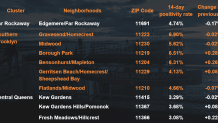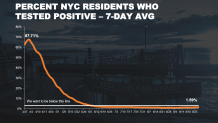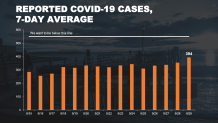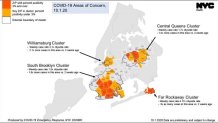What to Know
- The final wave of New York City public school students who opted for partial in-person learning return to physical classrooms Thursday; they were delayed as part of a strategic staggered return citywide
- New York City is the only major U.S. school district to have such an influx -- about a half-million kids -- return in person at this point; burgeoning clusters in 10 ZIP codes have sparked new public anxiety
- The city and state are both working to aggressively contain clusters in Brooklyn and Queens along with some in Rockland and Orange counties, which account for 26% of state cases the last two weeks
Twenty-one ZIP codes considered to be "areas of concern" in New York state given alarming increases in COVID cases now are averaging a 6.5 percent positivity rate, a full percentage point increase overnight, Gov. Andrew Cuomo said Thursday.
They now account for 26 percent of all statewide cases the last two weeks, despite representing just 6 percent of New York's total population.
Cuomo once again called on local governments in New York City, home to half of those ZIP codes, and in Rockland and Orange counties to aggressively executive compliance and test-and-trace strategies, warning of potential consequences New Yorkers have experienced all too painfully already over the last year.
The 20 ZIP codes that Cuomo named Thursday, plus one more that the city announced later in the day, are driving a slow uptick in the state's daily infection rate, which hit 1.3 Thursday. Prior to the clusters, it had a 38-day stretch below 1 percent, though the seven-day rolling average is still around that number. Hospitalizations are also ticking up statewide, climbing back above 600, a 50 percent jump in recent weeks, Cuomo has said. Sadly, more deaths could follow -- tragedy the hardest-hit state in America can least afford to endure, to any degree, again.
"These ZIP codes require full attention and effectiveness and action. A cluster today can become community spread tomorrow," Cuomo said. "These ZIP codes are not sealed. They go to surrounding communities. If you take out these ZIP codes, the rest of the state is where it's supposed to be."

In New York City, the increases come as the final wave of blended-learning students returned to physical classrooms for the first time Thursday, adding to the hundreds of thousands already in school buildings and fueling deeply intensifying concerns as more and more neighborhoods appear to be affected by the clusters.
For the five boroughs, the concern initially started with six ZIP codes in Brooklyn and Queens. That has since nearly doubled, with the city adding a 10th on Wednesday and an 11th on Thursday in Brighton Beach/Manhattan Beach/Sheepshead Bay. Positivity rates within many of them continue to grow, some notably, on a daily basis. The growth was less significant Thursday than in previous days, Mayor Bill de Blasio said at his daily briefing, and there were some declines -- but the number of ZIP codes on the city's watchlist is also expanding regularly.
The clusters are beginning to affect the city's overall infection rate on a seven-day rolling average. On Tuesday, that rate was 1.38 percent. It climbed to 1.46 percent Wednesday and hit 1.59 percent on Thursday, the same day New York City saw its highest daily new case average in well more than a month (394).
On Thursday, the Health Department said it issued a new order that gives city agencies the authority to close businesses for repeated noncompliance with state and local COVID health requirements.


The latest increase has stoked new tension across those clusters areas and New York City as a whole as the final wave of its more than 1 million students return to brick-and-mortar classrooms for the first time in more than a half year Thursday. The city is set to begin testing up to 20 percent of students and staff in every building monthly starting next week, part of an overall strategy to identify cases early, launch contact tracing and isolate individuals as needed to avoid spread.
The city's largest teachers' union has once again put the city on notice, warning up to 80 public schools in and around the affected ZIP codes could once again be closed if the numbers continue to rise. Mayor de Blasio has said the situation does not yet warrant re-closure of public schools, but he's monitoring it closely.
He hailed the return of students to another 1,600 city school buildings, the last group to join their younger cohorts in returning to physical classrooms, as an "amazing moment." The schools are open; the mission is to keep them that way -- though Schools Chancellor Richard Carranza said the city won't hesitate to close them if the public health situation warrants.
The teachers' union remains leery. Its president ratcheted up tensions Thursday, saying the mayor's all-or-nothing 3 percent threshold for closing schools citywide "does not work for us," and that a court fight -- or "something else" -- was looming if the city didn't close schools before the positivity rate reaches that tipping point.
Fewer than a dozen ZIP codes in Brooklyn and Queens have accounted for roughly 25 percent of the city's new daily cases over the last two weeks, despite representing a much lower percentage of the population. But many of the affected areas are heavily Orthodox communities, which often use their own private schools, yeshivas, or daycares and interface less with public schools.
"We have a very unusual situation here where we have an uptick in a discrete set of ZIP codes and we are not seeing an interconnection to our public school system," de Blasio said Wednesday. "We will watch it very carefully, daily, hourly. And if at any point we determine we need to close an individual school or any number of schools in that area, we will."
Daily Percentage of Positive Tests by New York Region
Gov. Andrew Cuomo breaks the state into 10 regions for testing purposes and tracks positivity rates to identify potential hotspots. Here's the latest tracking data by region and for the five boroughs. For the latest county-level results statewide, click here
Source: ny.gov
While the city's daily and seven-day positivity rates remain low compared with those in some other major cities, they have officials and the public alike on edge. Overall hospitalizations and daily COVID case averages are beginning to tick up as well in New York City as well as the state. If the rolling seven-day positivity rate hits 3 percent, de Blasio has said public schools citywide will be closed again.
If a school reports a single case in a classroom, that classroom will immediately move remote for two weeks as contact tracers assess exposure risk. If two cases in separate classes are confirmed and tracers don't immediately find a clear link, the entire school could move remote for at least two weeks, maybe longer.
PS721Q in Elmhurst, Queens, became the first high school to shut down for 14 days, even before it officially welcomed students back to class in person. A letter from the principal Wednesday night said two or more members of the school community had tested positive and further investigation indicated the need for a two-week in-person hiatus. The contact tracing effort is ongoing.
Statewide, schools have reported that at least 1,200 students, teachers and staff have tested positive since the start of the academic year in early September, Cuomo said Thursday, though that number is almost certain to be an undercount.
COVID-19 at New York City Public Schools
This map shows all known cases of COVID-19 at New York City public schools. It is updated Sunday through Friday at 5:30 PM.
Building that has been closed
One or more classrooms has been closed
A member of the school community has tested positive but the school community was not exposed
Source: nyc.gov
The latest hotspot ZIP codes in New York City are Fresh Meadows/Hillcrest, where a 3.08 percent positivity rate was last reported, and Brighton Beach/Manhattan Beach/Sheepshead Bay, where the positivity rate jumped from 2.97 % to 3.4%, according to the city's Department of Health. Nine of the eleven areas saw increases in positivity rate from Wednesday, the department said (with only Gerritsen Beach/Homecrest/Sheepshead Bay and Kew Gardens Hills/Pomonok going down a bit), and the areas have positivity rates that are nearly 3.5 times higher than the rest of the city.
There were also seven neighborhoods that are still under the 3 percent threshold, but the city is still monitoring as cases have shown significant signs of growth in that area.

The clusters outside the city, in Rockland and Orange counties, are seeing significantly higher positivity rates but are testing tens of thousands of fewer people each day, so the sample size is much smaller. There has also been a smaller uptick in Westchester County's New Rochelle, where back in March was where the first case on the east coast was detected. The city is well below the number of cases it was seeing in the spring, but with 57 active cases as of Thursday, it's up about 20 from just a few weeks ago.
In New Jersey, there is also growing concern regarding a spike there too. Ocean County's largest city, Lakewood, had 27 percent positivity. Cases are soaring in that city's orthodox community, although synagogues and schuls have starting posting signs about wearing masks and getting tested, with locals saying compliance has improved. The state also said it will be sending three mobile units down next week to conduct thousands of tests.
Cuomo has blamed the "incompetence" of local governments for the upticks, saying the clusters are a product of lacking enforcement. He issued a stern warning to local officials this week: "Either you do the job or people will die."
"We know how to contain the infection rate. We're just not doing it with these clusters," the governor said in a telebriefing with reporters. "This kind of incompetent activity will cost lives. I'm not going to let it happen."
Cuomo said he spoke about mask compliance with Orthodox leaders in various hotspot areas, as the city says it has done, though the governor says New York City should be well past the point of needing to educate to get people to mask up.
City officials, though, say enhanced communication appears to be working; it issued no fines on the first day of its mask crackdown. Mask compliance is one of the most critical tools in the arsenal for slowing spread and saving lives, officials say. It becomes only more critical as more people regain some semblance of daily activity outside their home, with more businesses reopening, more children returning to school in person and indoor dining resuming in the city this week. Some transit workers have said that the education period is over, and pushed for fines for bus and train riders if they are not wearing a mask.
Tracking Coronavirus in Tri-State
There were indications of progress on the compliance part in some neighborhoods Wednesday. Jewish leaders in Borough Park were gearing up to hand out 400,000 masks in their area. In Forest Hills, mask compliance was near 100 percent at a kosher food pantry that has been handing out 1,000 meals per week amid the pandemic. In Rockland County, several yeshivas put out a new order saying children should not be seen without masks.
Amid the heightened concerns, Cuomo debuted a new, free COVID alert app Thursday that notifies users if they've spent more than 10 minutes within six feet of someone who tested positive. Find more details on that here.



